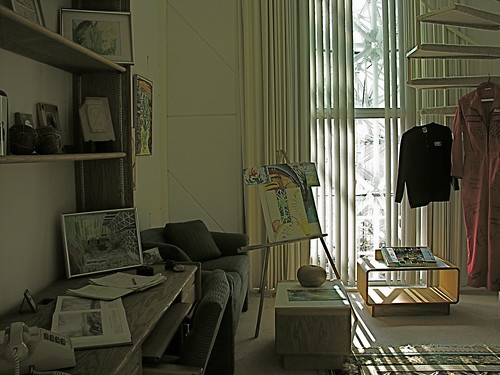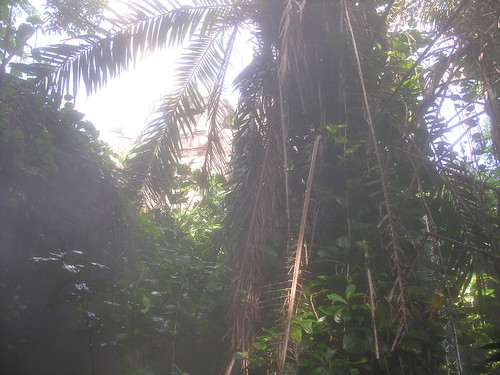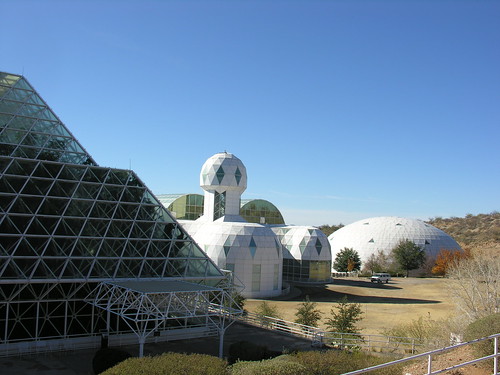Travel to Biosphere 2: Science’s version of Big Brother
Posted in Adventure, Arizona, Scenery, Science, Southwest, Travel | By Shelley Gillespie | Tags: Arizona, Historic, Scenery, Science, Southwest, Travel, Unique
In September, 1991 until September, 1993, eight people lived together in one very large “house,” Biosphere 2. (The earth is considered Biosphere 1, so you don’t need to go looking for the original version of the Biosphere.) This unique location north of Tucson, Arizona had eight scientists who volunteered for the project committed to living on what they could grow for themselves while studying the various effects of closed environments. They also maintained the facilities by themselves and rotated chores like cooking.

Biosphere 2 - giant science experiment
Much like the TV reality series, “Big Brother,” the scientists had to make things work while they spent 12-14 hour days running their experiments, maintaining the equipment that kept their oxygen and other essentials functioning, cooking and growing crops. They did not leave Biosphere 2 during the two years, but did maintain a connection with the outside world using telephones.

Two-story crew quarters at Biosphere 2
The Biosphere no longer has crews that live exclusively in closed environments, but important experiments are still being conducted on 3 acres of the 34-acre campus of the 1,600-acre property, now managed by the University of Arizona. The facility is able to simulate environments like rainforests, savannahs, deserts, tropics and marshes, while controlling every aspect of moisture levels, nutrients and the like. So, experiments can be conducted that teach scientists about the impact of droughts and other climatic changes that impact people.

"Rainforest" in Biosphere - every plant was quarantined for a year before planting
In addition to the 8-member crew in the early ‘90s, in 1994, a 7-member crew lasted about six months in the environment.
What made it difficult was that during their long working days, they were only able to grow enough to live on 1,200 calories a day, considered a very low calorie intake. They raised goats, chickens, rice, tilapia and vegetables.
Biosphere 2: The buildings
Spending $150 million to build the facility, every effort was made to use, then current, state of the art environmentally friendly materials and standards. The 6,500 windows of the project used double glass panes with plastic sandwiched in the middle to insulate. They only used second growth lumber, natural oils for wood stains, low volatile organic compound materials, and other appropriate earth friendly products.

Amazing geometry makes up the buildings
The geometry of the buildings is an interesting juxtaposition against the desert hillsides where they are tucked in, not visible to the outside world. The ceilings soar to as high as 90 feet, so the buildings are impressive.
Now, conferences can rent use of the casitas, campus-like buildings that skirt the Biosphere 2 experimental area. The environments themselves can be simultaneously testing projects like the decomposition of consumer materials (soda cans, etc.) in several different environments. For example, the schoolchildren running the desert trash project found that it was not decaying rapidly at all in the desert areas, but were experiencing faster decomposition in the wet environments.
Touring Biosphere 2
Visitors are welcomed on a daily basis with fees as high as $20 for adults, $18 for seniors and a discount for AAA membership to $18. Young children may have a hard time keeping up and would probably not find the tour compelling.
Tours are given about every 45 minutes that last 1 ¼ hours. The tour guides are knowledgeable and do not drone on, but have interesting information to share. They will answer questions.
Come prepared to walk – up, down, around. The walking is strenuous and some of the buildings are not handicapped accessible. There are ramps for same of the campus walkways, but much of the tour involves stairs, which can be slippery from the wet environments.
Visitors can tour some of the areas on their own, like the crew habitats and the tropical displays with very colorful fish. Otherwise, you follow the tour guide. (We had 31 people on our tour.)
There is a campus café, if you get hungry. The guide who greets you suggests you head to the movie theater where all visitors are directed to see a film on an endless loop with background about Biosphere 2. I recommend that you see the film so you know something about what you will see.
Science does come alive on some parts of the tour. It is amazing to think of the variations scientists can use to study the earth’s environments.
One major message is how very expensive it is to do these studies, thus the pricey admission fee for the tour.
If you have any interest in the earth and science, I highly recommend a trip to Biosphere 2.
Extra added attraction

Phoenix Mars Mission spacecraft
Oh, and if you visit before May, 2010, you can see the Phoenix Mars Mission spacecraft before it heads to the Smithsonian in Washington, DC. Before it returned to earth, it had generated 25,000 images from Mars. That’s a lot of photos, but for the price tag ($457 million) that’s a pricey set of photos!
Come back tomorrow for a visit to the southernmost Arizona casino hotel.
Tags: Arizona, Historic, Scenery, Science, Southwest, Travel, Unique

December 22nd, 2009 at 7:01 am
[...] Original post: Travel Tips and Adventures » Blog Archive » Travel to Biosphere 2 … [...]
December 22nd, 2009 at 4:33 pm
I’ve never been to Biosphere 2, but it sounds amazing.
Thanks for the tip!
December 30th, 2009 at 8:26 am
Great to have knowledgeable as well as humorous tour guides. Most people love to have fun on a visit, yet learning about local culture, life and people.
http://www.OurExplorer.com
local guides, local wisdom
January 10th, 2010 at 10:42 am
We are a group of volunteers and starting a new initiative in a community. Your blog provided us valuable information to work on.You have done a marvellous job!